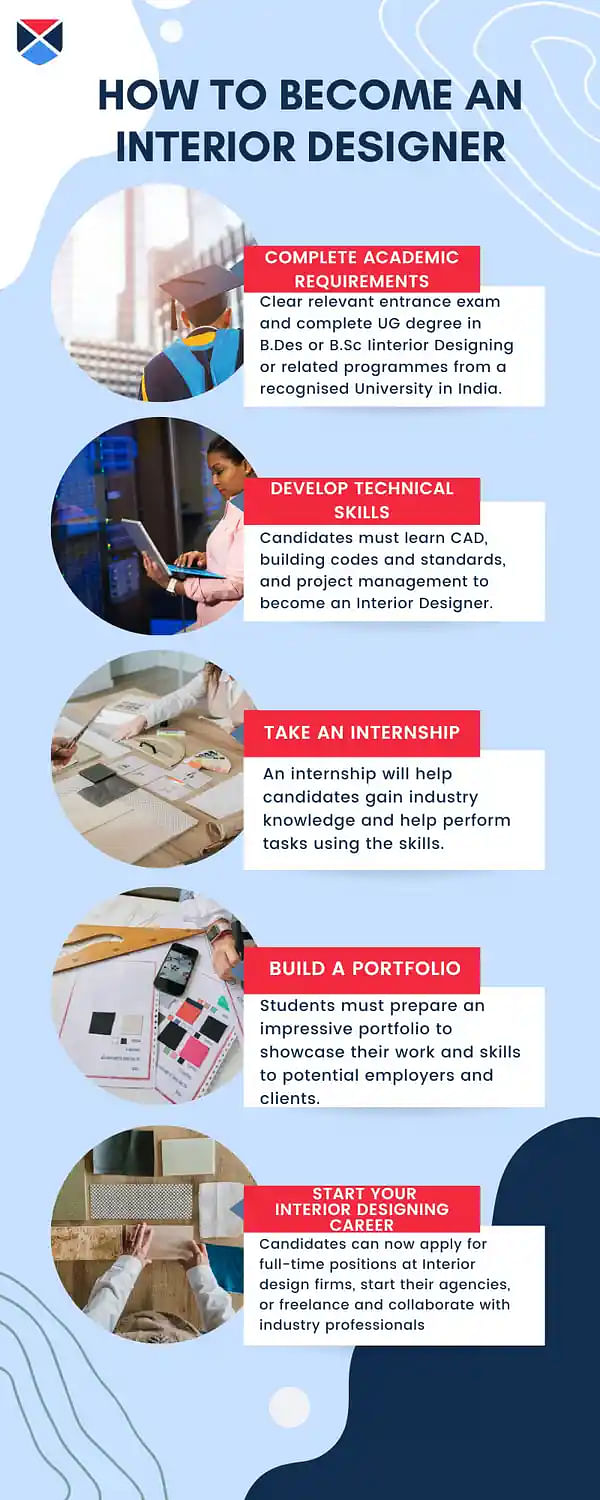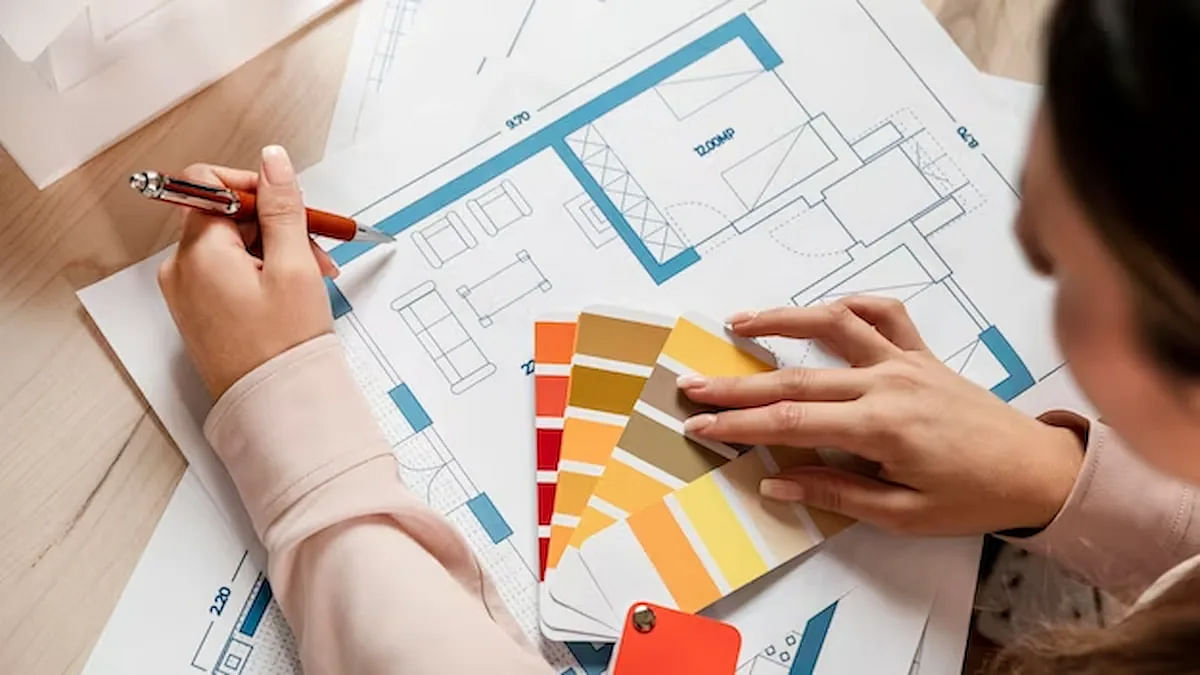Is being a Interior Designer your dream career option? Check out the complete step by step process on how to become a Interior Designer Eligibility, Exams, Skills Required and Salary in 2023.
Interior designers are responsible for designing spaces using their creative and technical skills. They plan the design of a property keeping in mind the overall functionality. Additionally, they work with CAD software to bring their visions into reality through 2D and 3D imaging. Candidates willing to pursue the occupation can expect a steady growth of 0.91% over the coming years.
To become an Interior designer, aspirants must complete their degree levels in B.Sc Interior Design or related courses. Further, they must upskill by learning different tools, such as Archicad, to improve efficiency. Next, they must create an impressive portfolio representing their strong suits. Candidates must take an internship to land a job or start as a freelancer.
Table of Contents:
- How to Become an Interior Designer?
- Who is an Interior Designer?
- What Does an Interior Designer Do?
- Skills Required to Become an Interior Designer
- Types of Interior Designers
- Salary of an Interior Designer
- Career Scope as an Interior Designer
How to Become an Interior Designer?
Candidates wanting to learn how to become an Interior Designer must know the following steps to build a career in the industry. In the process, aspirants are required to gain the relevant academic qualification, acquire technical skills, take an internship, build their portfolios, and work in a full-time role or operate through freelancing.
- Step 1: Complete Academic Requirements
- Step 2: Develop Technical Skills
- Step 3: Take an Internship
- Step 4: Build a Portfolio
- Step 5: Start Your Interior Designing Career

Step 1: Complete Academic Requirements
Candidates can take up any stream, such as Arts, Science or Commerce, to pursue degree-level Interior design courses. However, for a B.Sc in Interior design, institutes often require candidates to complete higher secondary with PCM. Candidates can check the academic criteria levels to determine if they wish to become interior designers after the 12th.
Clear Entrance Exam
If students wish to pursue Interior design at a degree level, they must take entrance exams such as SEED, UCEED, NID DAT, AIEED and NIFT etc. Some of the interior design-based entrance exams in India are mentioned below:
| Top Interior Design Entrance Exams in India | |
| CUET | UID DAT |
| SEED | AIEED |
| Pearl Academy Entrance Exam | IIAD |
| DE-CODE | ISDI Challenge |
| NICC Entrance Exam | AMU Entrance Exam |
| MDAT | GD Goenka DAT |
Interior Designer Books to Study
Additionally, candidates can amp up their knowledge by studying concepts of Interior Design from the following books for their entrance exams,
- UCEED B.Des Entrance Books and Test Series by AFAINDIA
- NIFT/NID/IIFT Entrance Examination by Shadan Usmani
- Seeds for CEED by Bhushan Patil
- Lucent's General Knowledge by Manvendra Mukul, R.P Suma, Renu Sinha, Sanjeev Kumar and Vinay Karna
- Wren and Martin by PC Wren
Obtain a Degree
Candidates must obtain a Bachelor's Degree to have a successful career as an Interior Designer. Further, to advance their careers, they can complete their master's or take up a certificate or diploma course in Interior design. Some interior design courses students can opt for are mentioned in the table below.
|
Undergraduate Courses |
Postgraduate Courses |
Certificate/Diploma Courses |
|
Certificate Course in ID |
||
|
Master of Interior Design |
Diploma in ID and Architecture |
|
|
BFA Interior Design |
M.Des Interior Designing |
PGD in Interior Interior Designing |
|
Bachelor of Interior Design |
MA Interior Design |
- |
Read More:
| Interior Design Courses after 10th | Interior Designing Courses after 12th |
Top Interior Designing Institute in India
Candidates can check the top institutes offering Interior Designing courses in India.
|
Interior Design College |
Average Annual Fee |
|
INR 3,54,000 |
|
|
INR 3,20,000 |
|
|
INR 4,87,000 |
|
|
INR 4,35,000 |
|
|
INR 8,500 |
|
|
Vogue Institute of Fashion Technology |
INR 3,86,000 |
|
College of Architecture |
INR 98,000 |
Read More: Top Interior Design Schools in India
Step 2: Develop Technical Skills
Candidates must ensure they are skilled in CAD, building codes and standards, and project management to become an Interior Designer in India. Some of the top technical training candidates must acquire are,
1. Computer-aided Design (CAD)
Candidates need to take a 6-month to 1-year course to get a certificate in Computer-aided Design. Candidates learn concepts on analysis of space frames, sketch entities, tools, geometry, dimensional constraints, interactive design, and smart dimensions. Some softwares that will be helpful to learn are,
- Live interior 3D: It is a platform for designing detailed floor plans and 3D rendering.
- Archicad: Manages common aspects of aesthetics and engineering.
- Sketchup: A 3D modeling program used to create mockups.
- Adobe Illustrator: Majorly used to create vector graphics based on formulas.
- Adobe Photoshop: Primarily used to raster and edit images. Also in graphic and digital design.
2. Building Codes and Standards
Candidates must learn of the building codes and standards applicable in India. Students must study the codes, which entail administrative regulations, development control rules, building requirements, fire safety requirements, material regulations, construction safety, and plumbing services.
3. Project Management
Candidates must be proficient in the management of interior projects and manage all aspects like budget, schedule, vendor management, etc. It also includes setting timelines, meeting deadlines, analyzing risks, etc.
Also, Check: List of Top Skill Development Courses
Step 3: Take an Internship
Once candidates have gained relevant academic qualifications and mastered the skills to become Interior Designers, they must apply for an Internship. An internship will help candidates gain industry knowledge and perform tasks using the skills acquired through academic training.
Aspirants must apply for an internship at an Interior Design firm to understand the daily work and develop connections with people to establish a foothold in their future. Hence, candidates must take an internship to become an Interior Designer.
Step 4: Build a Portfolio
Students must prepare an impressive portfolio to showcase their work and skills to potential employers and clients. When creating one, they must include images from interior projects they have worked on, sample mood boards, sketches, CAD drawings etc.
Candidates who have a portfolio will always get leverage when acquiring projects. The portfolio is also a reflection of self, and since candidates are in a creative field, they must understand that it is a crucial component of becoming an Interior Designer.
Step 5: Start Your Interior Designing Career
Candidates can now apply for full-time positions at Interior design firms, start their agencies, or freelance and collaborate with industry professionals. In India, the Interior Designing industry has seen massive growth over the past decade, with people taking more interest in increasing the functionality of space while making it aesthetically pleasing.
| How to Explain Project in an Interview? | Tips on How to Introduce Yourself in an Interview |
Who is an Interior Designer?
An interior designer is an expert who helps convert spaces into a functional environment using design, colours, materials and lighting. Their job includes space planning, conceptualising, implementing and transforming properties using their creative and technical skills.
Interior designers also work collaboratively with industry experts such as architects, engineers, designers and vendors such as electricians, painters, plumbers and more. Importantly, interior designers understand the client's requirements and execute designs based on the client's budget.
What Does an Interior Designer Do?
Interior Designers to the commoner design homes and offices, but their scope of work is more than what meets the eye. They manage different aspects of the designing process, keeping the client's requirements in mind while bringing in their skills and expertise to build a space that reflects both the interior designer and the client. Here are the main job roles of an interior designer,
- Interior designers conceptualise interior designs for a property by following a systematic process of briefing, researching, selecting and implementing design components.
- It starts with installing lights, selecting the upholstery, designing the furniture, determining the correct colour palette and choosing the decor.
- They communicate with internal and external stakeholders to ensure client briefs are met.
- They work per the budget set by the client and work out an estimate accordingly.
- Interior designers also work closely with contractors, engineers, plumbers, etc., to bring their designs to life.
- They update clients regarding the progress of sites and let them know of changes or hurdles to work around them.
Also, Check: How to Become an Animator?
Qualifications to Become an Interior Designer
Candidates must complete their foundational level education in any stream, however, they must secure 50% and above in Physics, Chemistry and Mathematics to be eligible for admission to top interior designing colleges in India.
Further, aspirants must acquire a degree in Interior Designing such as B.Des Interior Designing, followed by M.Des. After completion, they must build their technical skills on CAD software and other designing tools such as Adobe Photoshop.
Simultaneously, candidates must build their portfolios showcasing their work and skills. Taking on solo hand-on-projects will also prove to be highly beneficial when candidates are looking for a full-time job or pitching to potential clients.
Also, Check: List of Fashion Designing Entrance Exam After 12th
Education Career Paths
Essentially, candidates can choose three routes to becoming an interior designer, they are,
- Candidates must complete 10+2 in any stream, complete their B.Des followed by M.Des.
- They can complete 10+2 with Mathematics, study B.Sc Interior Designing and later take up M.Sc Interior Designing.
- Lastly, they can clear 10+2 with Mathematics, graduate with B.Arch, and complete post graduation in M.Des Interior Design.
Skills Required to Become an Interior Designer
Interior Designers require many skills to build a successful career in the industry. The skills below are the most important to become an Interior Designer.
Technical Skills
CAD technology and other computer software are essential for candidates aspiring to become interior designers. Candidates must be adept in software such as Autodesk AutoCAD, ARCHICAD, Draftsight, CAD Pro, CorelCAD etc. These software skills will help aspirants transform their design ideas into 2D and 3D models. Candidates skilled in software tools have a higher chance of being hired and working on big projects.
Spatial Understanding
Candidates must be skilled enough to perceive spaces and understand the structure to maximise a property's design and utility. They must know how to use each nook and corner and where not to use them, keeping codes and building structure in mind. While increasing the functional aspect, they must know how to consider the design aspect while keeping things highly effective.
Creativity
One of the vital skills required is creativity, as candidates need to visualise spaces, bring in functionality, understand which furniture and appliance will work the best and select the right theme for the property following the client brief while maintaining individuality. These creative implementations are made easy with the diverse technology and programmes available in today's day and age. Making a selection of colours, matching, contrasting and finding the perfect fit easier for Interior designers.
Critical Thinking
Candidates will face various problems related to plumbing, electrician, meeting client requirements etc. They must manoeuvre these difficulties and develop reasonable solutions to deliver high-quality work. Moreover, as they work on deadlines, candidates must be able to solve them within the specified time. Sometimes the requirements are high from the client's end; this is when they must think differently and stand out.
Attention to Detail
Aspirants must have an eye for details as an Interior Designer. First and foremost, they must pay careful attention to the client's specifications. With the brief, they must move work to provide results in the future. However, at every stage, an Interior designer must inspect if all the deliverables meet the quality standards. Providing faulty solutions and overlooking the client's needs will hamper the final work as an Interior Designer.
Project Handling
Candidates must be equipped to handle projects with professionalism. They must handle various aspects such as budgeting, negotiations, maintaining records and dealing with different management systems. The handling of a project requires not only creativity but also strong financial and numerical skills. Hence, candidates must master all the requisites of project planning to succeed as Interior Designers.
Also, Read on 5 Key Steps for Career Planning and Development
Types of Interior Designers
Candidates who pursue Interior Designing can take on various designations once they have decided on the niche. Each designation has its unique set of responsibilities.
Interior Designer
An interior designer is someone who designs internal spaces. Elements they use are furnishing, colour, fittings, lighting etc. They keep in mind the client's requirements to design the property.
Landscape Designer
As a Landscape designer, candidates will work in designing open spaces like gardens, parks, playgrounds, arenas, campus areas etc. They use elements such as plants, installations etc.
Commercial Interior Designer
A commercial interior designer designs large spaces such as malls, offices, museums, restaurants, galleries, convention centres, etc.
Lighting Designer
A lighting designer is responsible for planning the lighting of a space and visualising how it will impact the surroundings. They help clients decide which lighting will best suit a home, office or open space to amplify the beauty of a property.
Colour Specialists
A colour specialist is a consultant who decides which colours a client should use and which colours not to use in a space. They evaluate other design elements and come up with the best colour solutions.
Salary of an Interior Designer
The average salary of an Interior Designer in India is INR 3,22,272 PA. Candidates can earn up to INR 6,40,000 PA in a full-time position as Interior Designer. Candidates can check the designation-wise Interior designer salary below.
|
Designation |
Average Annual Salary |
|
Interior Designer |
INR 3,00,000 PA to INR 10,00,000 PA |
|
Commercial Interior Designer |
INR 6,04,000 PA to INR 12,00,000 PA |
|
Interior Decorator |
INR 4,00,000 PA to INR 8,00,000 PA |
|
Lighting Designer |
INR 2,00,000 PA to INR 15,00,000 PA |
|
Landscape Designer |
INR 4,11,000 PA to INR 8,00,000 PA |
Also, Check:
Top Recruiters for Interior Designers
Interior Designers can look for opportunities in several companies. Some renowned companies to work as an Interior Designer are,
- Interia
- Inch
- Livspace
- Bonito Design
- Pepperfry
- Films Factory
- Effervescent Technologies
- Acropolis
- Essajees Atelier
- Urban Ladder
Advantages of Becoming an Interior Designer
There are multiple pros and cons attached to becoming an Interior Designer. Candidates interested in pursuing a career in the industry can weigh the main benefits of becoming an Interior Designer,
- Every day is a new challenge, with an exciting stream of work involving creativity.
- Candidates get to channel their creativity through live projects.
- Interior Designers are extremely resourceful as they communicate and network with various interior industry professionals.
- Candidates get paid a lump sum once established in the field.
Drawbacks of Becoming an Interior Designer
The disadvantage of becoming an Interior Designer is,
- Dealing with clients is one of the most difficult jobs as an Interior Designer.
- They have to deal with multiple vendors, which can be stressful.
- It takes up a lot of time for interior projects to complete.
- Interior Designers work with big teams, without which they cannot succeed.
Career Scope as an Interior Designer
There is a massive career scope as an Interior Designer in India. It is a reputed job which is both creative and technical. Young students aspire to establish themselves as Interior Designers because the salary is higher than in most creative industries. Moreover, if the candidate works as a freelancer, their chances of earning an attractive pay increase.
- Growth Opportunities: Candidates have the opportunity to work in different sectors like residential, corporate, etc., which equips them to work on both big and small-scale projects.
- Career Choice: Candidates can work as bedroom designers, landscape artists, and colour specialists per their interests.
- Increases Creativity: Candidates can channel their artistic skills in the field by playing with colours, patterns, furnishing, upholstery etc.
- Flexibility: Interior designers' work hours are usually flexible, as they mostly operate independently once they have gained enough experience.











POST YOUR COMMENT